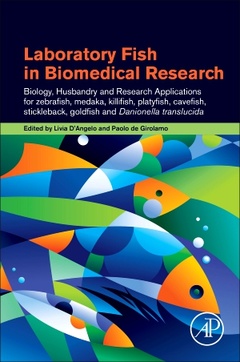Laboratory Fish in Biomedical Research Biology, Husbandry and Research Applications for Zebrafish, Medaka, Killifish, Cavefish, Stickleback, Goldfish and Danionella Translucida
Coordonnateurs : D'Angelo Livia, de Girolamo Paolo

1. Biology and research applications
Brautigam Lars and Filipek-Go´rniok Beata
2. Housing and maintenance of zebrafish, new technologies in laboratory aquatic systems and considerations for facility design
Bruce Newell and Marco Brocca
3. Breeding and larviculture of zebrafish (Danio rerio)
Benjamin Tsang and Robert Gerlai
4. Health monitoring, disease, and clinical pathology
Jean-Philippe Mocho and Nuno Pereira
5. The welfare of zebrafish
Paul Georg Schroeder
6. Analgesia, anesthesia, and euthanasia in zebrafish
Almut Kohler and Ana M. Valentim
7. Transgenesis, mutagenesis, knockdown, and genetic colony management
Claire Allen, Francesco Argenton, Fredericus J. Van Eeden and Natascia Tiso
8. Sperm cryopreservation, in vitro fertilization, and embryo freezing
Kanav Khosla, John Bischof and Zolta´n M. Varga
Section 2: Other small freshwater fish
9. Medaka as a model teleost: characteristics and approaches of genetic modification
Tokiro Ishikawa, Yu Murakami, Chika Fujimori, Masato Kinoshita, Kiyoshi Naruse and Shinji Kanda
10. Integrated analyses using medaka as a powerful model animal toward understanding various aspects of reproductive regulation
Chie Umatani, Mikoto Nakajo, Daichi Kayo, Yoshitaka Oka and Shinji Kanda
11. The African turquoise killifish (Nothobranchius furzeri): biology and research applications
Gwendoline Astre, Eitan Moses and Itamar Harel
12. Challenges in keeping annual killifish
Martin Reichard, Radim Blazek, Iva Dykova, Jakub Zak and Matej Polacik
13. Mexican tetra (Astyanax mexicanus): biology, husbandry, and experimental protocols
Diana P. Baumann and Andrew Ingalls
14. The housing, care, and use of a laboratory three-spined stickleback colony
Ellen Blaker, Marion Sebire, Tim Ellis and Ioanna Katsiadaki
15. Goldfish (Carassius auratus): biology, husbandry, and research applications
Ayelen M. Blanco and Suraj Unniappan
16. Danionella translucida, a tankful of new opportunities
Gokul Rajan, Karine Duroure and Filippo Del Bene
Section 3: Databases
17. Fish inventory databases
Jana Oltova
Paolo de Girolamo is a veterinarian by background, he is full Professor at University of Naples, and he is in charge of Chief of Veterinary Officer and Ethical Animal Care and Use Committee. His research interests have been since long addressed to the neurobiology and gut-brain axis interplay in teleostean fish (goldfish, zebrafish, turquoise killifish etc.).
- Provides husbandry and management protocols, devices and water systems
- Shows strength and weakness of breeding
- Explores potential scientific applications and experimental protocols. with regards to the most used freshwater fish used for scientific purposes
Date de parution : 09-2021
Ouvrage de 474 p.
15x22.8 cm
Thème de Laboratory Fish in Biomedical Research :
Mots-clés :
Adaptation; African turquoise killifish; Aging; Analgesia; Anesthesia; Applications; Aquarium fish diseases; Astyanax mexicanus; Behaviors; Biological filter; Biology; Blind cavefish; Breeding; Ca2+ imaging; Care; Cas9/CRISPR; Comparative evolution; CRISPant; CRISPR/Cas9; Cryobanking; Cryopreservation; Culture; Danio rerio; Danionella translucida; Database; Development; Developmental biology; Diapause; Disease; Double promoter; Drug discovery; Ecology; Electrophysiology; Embryo; Embryo development; Embryonic development; Emerging technology; Environmental enrichment; Environmental factors; Environmental samples; Epidemiological unit; Euthanasia; Evolution; Eye degeneration; Facility; Filtration; Fish diseases; Fish health; Fish welfare; Fluorescent protein; Gene knockout; Genetic material; Genome engineering; Genotyping; Germplasm; Goldfish; HDR; Health monitoring; High-throughput screening; Histological tools; Histopathology; Hormonal assays; Hormones; Housing conditions; Humane endpoints; Husbandry



